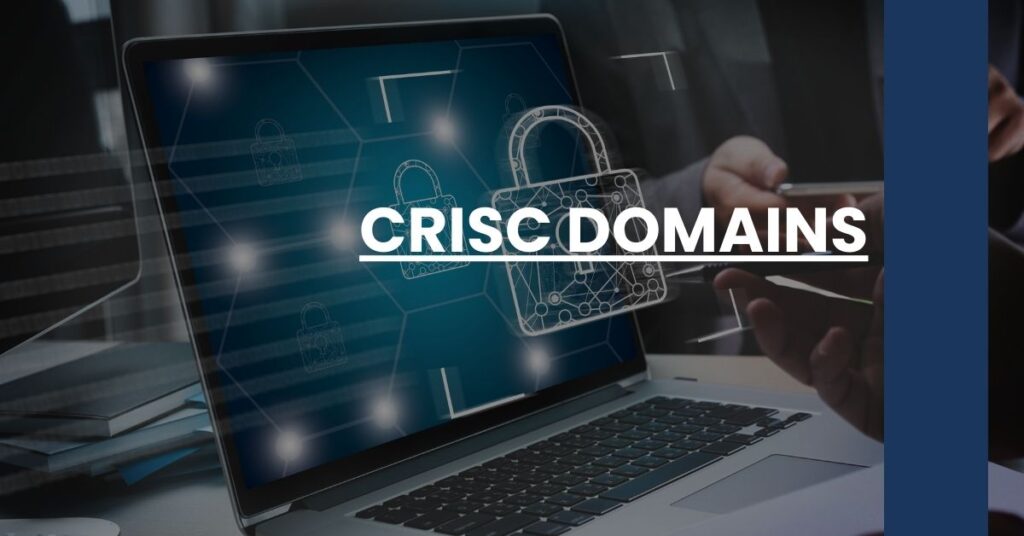CRISC domains are the pillars of the Certified in Risk and Information Systems Control (CRISC) certification, central to mastering the complexities of IT risk management.
In the realm of information technology and control, four crucial domains guide professionals:
- IT Risk Identification
- IT Risk Assessment
- Risk Response and Mitigation
- Risk and Control Monitoring and Reporting
Grasping these domains is key for anyone aiming to bolster their capabilities in securing and controlling information systems. With an understanding of CRISC domains, you’re set to navigate the challenges of IT risk with confidence.
- Introduction to CRISC Certification
- The Importance of CRISC for Professionals
- Domain 1: IT Risk Identification
- Domain 2: IT Risk Assessment
- Domain 3: Risk Response and Mitigation
- Domain 4: Risk and Control Monitoring and Reporting
- How CRISC Domains Align with Industry Practices
- Preparing for the CRISC Examination
- Conclusion: The CRISC Domains as a Blueprint for Success
Introduction to CRISC Certification
In the vast labyrinth of IT, where risks lurk at every corner, CRISC (Certified in Risk and Information Systems Control) emerges as a beacon for professionals eager to navigate these dangerous waters effectively. CRISC isn’t just a certificate; it’s a statement that you possess a robust skill set in identifying and managing IT risk and designing effective control systems. Your journey with CRISC equips you to talk to stakeholders in the language they understand: the language of lessened risk and heightened security.
Taking the CRISC certification signals that you are serious about your career in IT risk management. This certification, governed by ISACA, is recognized globally and has set the standard for assessing an IT professional’s ability to manage risks and implement strong controls within an enterprise.
The Importance of CRISC for Professionals
As you stand on the brink of potentially pursuing a CRISC certification, consider the doors it could unlock for you. Your CRISC journey tells potential employers that you are committed to excellence, understand the intricacies of IT risk, and can handle their organization’s unique challenges. It has been associated with higher earning potential and is highly regarded in industries rife with information systems and associated threats. When you choose to embark on the path of CRISC certification, you’re not just enhancing your resume, you’re making an investment into becoming a recognized authority in risk management.
Domain 1: IT Risk Identification
The Backbone of Risk Management
Risk identification is the cornerstone of effective risk management, and, naturally, it forms the first of the CRISC domains. You’ll dive deep into the world of potential threats and uncover the risks that could jeopardize an organization’s information systems.
- Identifying Threats and Vulnerabilities: By cataloging what could go wrong—from cyberattacks to natural disasters—you set the stage for a robust defense.
- Risk Register Development: You’ll learn how to record and prioritize risks, creating a keen awareness of which issues demand immediate attention.
- IT Systems Analysis: Understanding the complex workings of your organization’s IT systems is vital, as these are often the battlegrounds where risk is most prevalent.
- Business Impact Analysis (BIA): Different systems have different levels of criticality. BIA teaches you to discern which systems and risks could wreak the most havoc on business operations.
Your newfound expertise in risk identification isn’t just theoretical; it’s designed to be applied and makes you an asset to any risk-aware business.
Domain 2: IT Risk Assessment
Entering the second domain of CRISC, you become the detective in the story of IT risk, not only pinpointing risks but also assessing their implications. The IT Risk Assessment domain is about measuring risk, scrutinizing it with a magnifying glass, and understanding its potential impact.
A Closer Look at Risk Assessment
- Qualitative vs. Quantitative Assessment: You will become adept at both qualitative interpretations, where you’ll judge risks based on their nature and the organizational context, and quantitative techniques that assign numerical values to risks.
- Risk Scenarios: Construct well-informed scenarios to imagine ‘what if?’ and prepare for threats before they become a reality.
- Risk Modelling: This is where you’ll harness the power of data to predict risk behavior and outcomes, an invaluable skill that turns historical data into a blueprint for the future.
Equipped with these powerful assessment tools, you understand not just what might go wrong, but also its likelihood, and the potential depth of the chaos it could cause (Security Magazine offers insights into conducting effective risk assessments). It’s no longer enough to know that the monsters are out there; you’ll know their hiding spots and how to combat them. Your journey into the realm of CRISC deepens as we venture next into how to respond to these risks and mitigate their impact — a domain where strategies are forged, and resilience is built.
Domain 3: Risk Response and Mitigation
As you have identified and assessed the risks, you now step into the crucial phase of forming your battle strategy in Domain 3: Risk Response and Mitigation. It’s time to take action, and your CRISC training has prepared you for this moment.
Crafting Your Defensive Strategy
Risk Response Planning: Here, you adopt a tactical approach towards risks, deciding whether to dodge, confront, spread or embrace each risk. Do you avoid the risk altogether, transfer it perhaps via insurance, mitigate it with strategic changes, or accept it if it’s part of pursuing an opportunity? Choices made in this domain directly shape the risk landscape of your organization.
Implementation of Mitigation Strategies: You’ll orchestrate risk responses with the precision of a maestro, aligning every move with the organization’s risk appetite and strategic objectives.
- Mitigation Techniques: Discover and deploy a multitude of risk mitigation techniques, from the implementation of advanced security protocols to employee training programs. Each technique is a tool in your risk management arsenal, ready to be wielded against the specter of IT threats.
Developing these mitigation plans isn’t just about slapping a band-aid on the problem; it’s about weaving a layer of armor into the very fabric of your organization’s operations. When you’ve mastered this domain, you won’t just be reacting to risks—you’ll be proactively safeguarding the future. For more insights, take a look at the strategic perspectives shared at ProjectManager.
Domain 4: Risk and Control Monitoring and Reporting
In the finale of the CRISC domains, we delve into sustaining your defense over time. Domain 4 hones in on constant vigilance—ensuring that the systems and processes you’ve defended remain resilient.
Keeping a Watchful Eye
Continual Monitoring: Like a guardian, you’ll learn to keep an unwavering watch on risk and controls, employing tools and techniques that leave no stone unturned. Understanding the nuances of each metric and indicator enables you to detect anomalies before they burgeon into full-blown catastrophes.
Effective Reporting: Your ability to communicate risk status becomes vital, as the articulation of complex information in simple terms can empower decision-makers at every level of the organization.
- Reporting Frameworks: You will craft reporting frameworks that not only highlight the current risk statuses but also forecast potential future risks utilizing trend analyses and predictive indicators.
Your goal in this domain is to embed a risk-aware culture within the organization, ensuring that monitoring and reporting become as natural as breathing. Continual improvement drives the narrative here—because in the realm of IT risk, stagnation is akin to inviting disaster. Explore more about operational risk management practices at AuditBoard.
How CRISC Domains Align with Industry Practices
When we place the CRISC domains under the microscope of industry standards, it’s evident they’re more than just theoretical constructs. They align closely with recognized best practices, ensuring that your mastery over them is relevant, practical, and in demand.
By aligning with these domains, your capabilities are cemented in current methodologies and forward-thinking innovation, ensuring that your risk management practices contribute measurably to organizational stability and security. As industry standards evolve, so too does the CRISC, remaining a cutting-edge benchmark for the well-versed IT risk professional (Simplilearn).
Preparing for the CRISC Examination
As you approach the CRISC examination, consider it not just a test, but a crucible. Here your understanding of the CRISC domains is honed to sharpness.
Strategies for Success: Familiarize yourself with each domain, practice with real-world scenarios, and engage with a study group or take courses aimed at unpacking the complexities of these domains.
Remember, a thorough grasp of each domain’s intricacies is crucial, for the exam not only tests your knowledge but also how you apply it to problem-solving in a pressured environment. Commitment is your ally, and preparation is your path to triumph (Simplilearn).
Conclusion: The CRISC Domains as a Blueprint for Success
Your exploration of the CRISC domains has revealed the magnitude of what they offer—an intricate map guiding the savvy professional through the treacherous territory of IT risk management. With these domains as your blueprint, your journey is carved out with precision, leading to the pinnacle of professional success in the realm of risk and information systems control.
Remember, mastery of the CRISC domains not only sets you atop a platform of professional excellence but also brands you as a vanguard in a world increasingly dominated by digital risks. Invest in understanding these domains, and harvest the rewards as a titan in your field.

